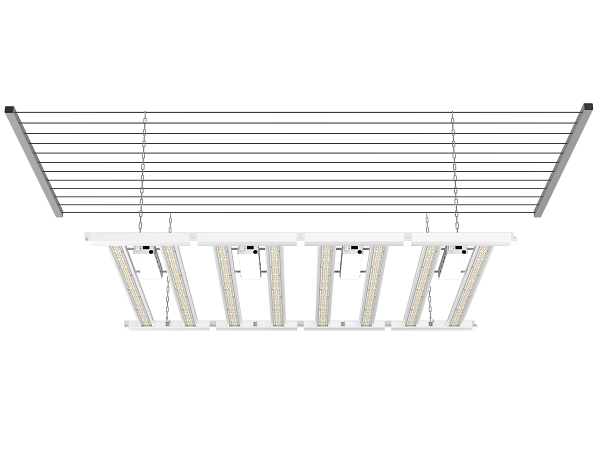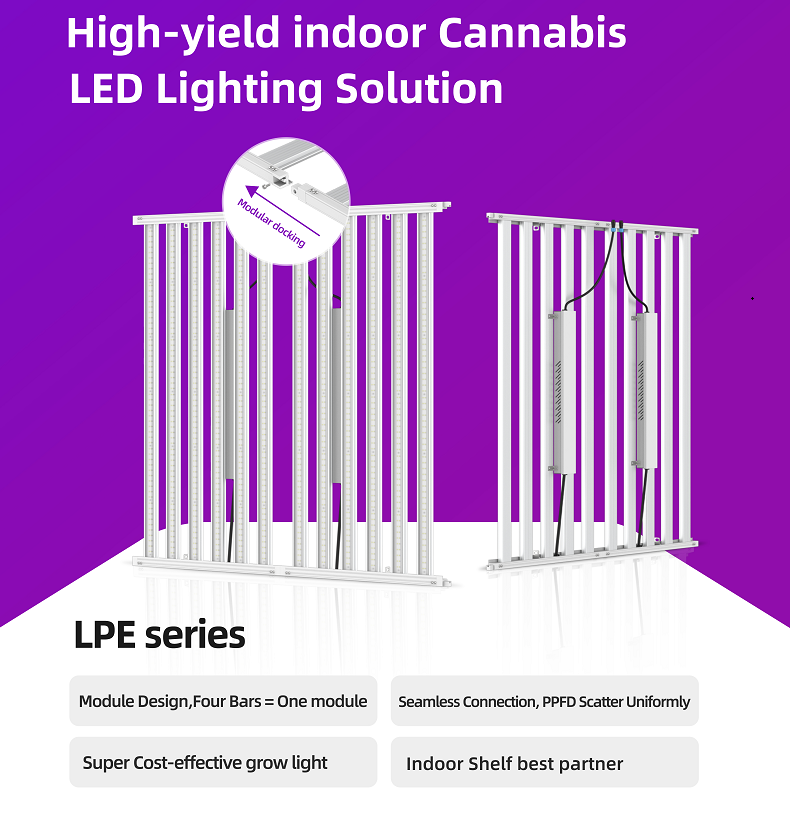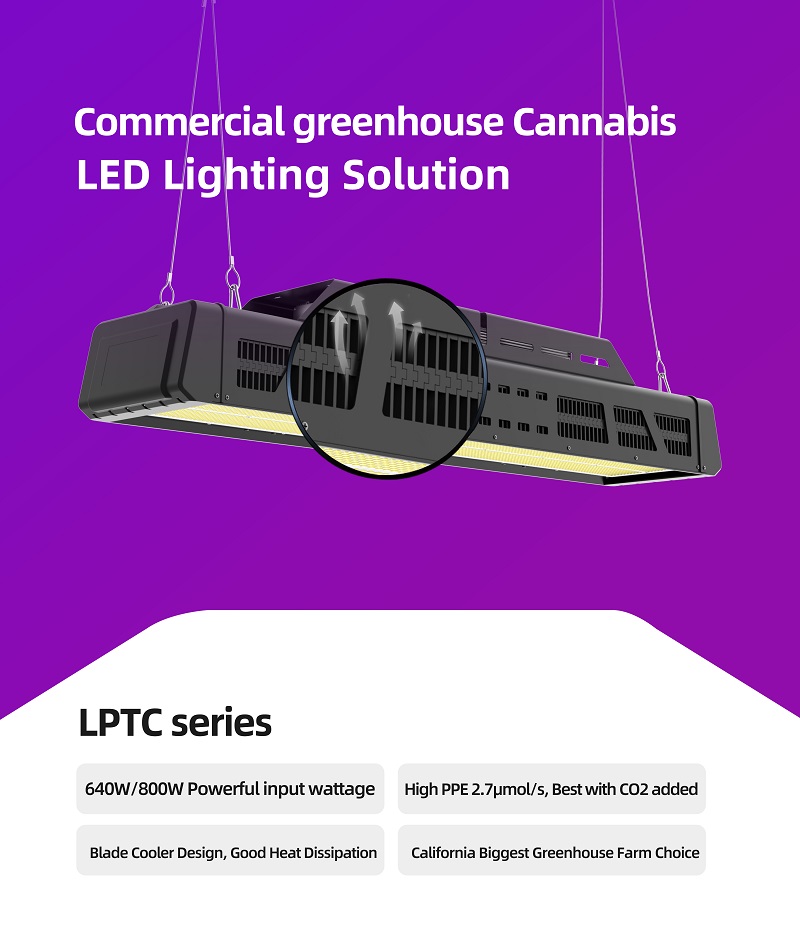When growing cannabis, the type of lighting you choose from your LED grow lights can significantly affect your plant's growth and yield. Fluorescent grow lights are favored by growers because of their efficiency and effectiveness. But how do different types of LED grow lights, fluorescent lights, affect the growth and yield of cannabis plants? Let’s break it down!
There are many types of fluorescent grow lights, each with its own unique features and benefits. Understanding these properties and benefits can help you make informed decisions for your cannabis cultivation.
LPU grow lights are known for their high output and efficiency. They emit a full spectrum of light suitable for all growth stages of cannabis. LPU is particularly effective at plant growth, promoting lush leaves and strong stems. Their slim design makes them easy to place in small spaces, making them a favorite among indoor growers.

Compact fluorescent lamps (CFLs) are another popular choice. Connected installations, they are small, versatile and relatively inexpensive. While they may not offer the same intensity as LPUs, they are great for small-scale jobs or to supplement other light sources. LPE is particularly effective in the early stages of growth, helping seedlings thrive.

High output fluorescent lighting takes things to the next level. Their lumens per watt are higher than standard fluorescent lights, making them a strong choice for serious growers. High output fluorescent lights are ideal for the growing and flowering stages of plants, providing the intensity needed to maximize yields.

The spectrum of light emitted by fluorescent grow lights plays a vital role in the growth and development of cannabis plants.
What is spectrum? full spectrum led grow lights
Although natural light may appear white to us, it is actually made up of many different colors. When light is passed through a prism, or when we see a rainbow, we can see the "true face" of sunlight. When light is refracted into its various parts, we can see all the colors that make up that light.
Over the years we have learned that plants actually make "decisions" about how to grow based on the light spectrum they receive. Different light spectrums can change the way cannabis germinates, grows and even flowers. While there aren’t many options for changing the spectrum of sunlight when growing outdoors, since many users now use grow lights, we have almost complete control over the spectrum when growing cannabis indoors!
Full spectrum lights simulate natural sunlight, providing a balanced range of wavelengths that cannabis plants need to photosynthesize. This is essential for healthy growth as it supports the plant's growth and flowering stages. Plants exposed to full spectrum light tend to show strong growth and higher yields.
This is a big question because each spectrum has its own unique effects, and some spectrums are more useful for growing cannabis than others. There is no "best" spectrum for growing cannabis, but users can create their own settings for their own goals and Choose the best spectrum for your growing space!
Different growth stages require different light spectra. For example, during the growth phase, plants benefit from blue light, which promotes leaf growth. In contrast, red light is more beneficial during the flowering stage and promotes flower bud development. Choosing the right spectrum for each stage can significantly impact your overall yield.
Light intensity is another key factor in growing cannabis. The amount of light a plant receives directly affects its growth rate and yield.
Lumen and plant response. Lumens measure the brightness of light. Cannabis plants require a certain level of lumens to thrive. T5 lights generally provide higher lumens than CFLs and are therefore more effective on larger plants or those in the flowering stage. Ensuring your plants receive adequate light intensity promotes healthier growth and increases yields.
The distance between LED grow lights and plants
The distance between the light source and the plant is also important. Fluorescent lights produce less heat and can therefore be placed closer to plants without the risk of burning them. However, if the lights are too far away, the plants may not get enough light, resulting in stunted growth and reduced yields.
Heat emissions and their effects
Heat dissipation is an important consideration when using fluorescent grow lights.
Manage heat levels
LED fluorescent lights produce less heat than other traditional high-power tube-type grow lights, which is a significant advantage. This allows growers to place the lights closer to the plants, maximizing light without the risk of overheating. However, monitoring heat levels to ensure optimal growing conditions is still essential.
Marijuana plants need bright light, at least some red and blue, for it to grow properly. While certainly not essential for healthy plant growth, it is considered a good form of choosing the appropriate spectrum of light to encourage growth during the vegetative and flowering stages of your cannabis plant.
However, keep in mind that different strains will be affected differently by the spectrum. Some plants are barely affected, while others may react more strongly. It's important to remember that the changes caused by light spectrum are relatively small (such as stems tending to grow longer), whereas many other factors drive some of the same changes.
Compare growth and yield results
So, what are the differences in plant growth and yield between these different types of fluorescent lights?
LPU vs. LPE: Which is better?
LPU lamps are generally better than LPE in terms of growth and yield. Their higher lumen output and wider spectral range make them ideal for all growth stages. While LPE is great for small plantings or seedlings, LPU lights are the first choice for growers looking to maximize yields.
In summary, the type of fluorescent grow light you choose can significantly affect the growth and yield of your cannabis plants. LPU, LPE and LPTC lamps each have their own unique advantages and disadvantages. By understanding how these lights work and their impact on plant growth, you can make informed decisions that will result in healthier plants and higher yields.
FAQ:
Which fluorescent grow lights are best for cannabis?
LPU grow lights are often considered the best due to their high output and full spectrum capabilities.
Can I use LPE to illuminate flowering cannabis plants?
Yes, LPE can be used for flowering, but they may not provide the intensity needed for optimal yields compared to LPU or LPTC lights.
How far away should fluorescent lights be from cannabis plants?
Fluorescent lights can be placed 6 to 12 inches from plants, but watch for any signs of stretching or light burn.
Do fluorescent lights produce a lot of heat?
No, fluorescent lights produce less heat than other types of grow lights, making them safer to place close to your plants.
How does light spectrum affect cannabis growth?
Different light spectra support different stages of growth; blue light is best for plant growth, while red light promotes flowering and bud development.
Luxgrow is developed by photology engineers and more than 13 years R & D engineers team in led lights
As a professional and rich experience grow light designer and manufacturer for indoor greenhouse farms ; Luxgrow really knows offer the exclusive customized layout service is very necessary and cost-efficient.
We offer free exclusive customized layout service for customers , not only in the lighting configuration help,but also help you know the budget